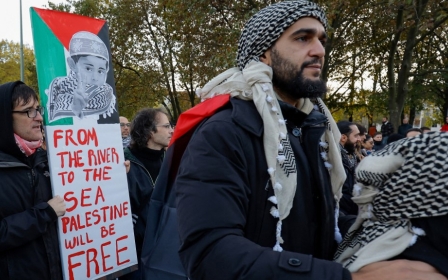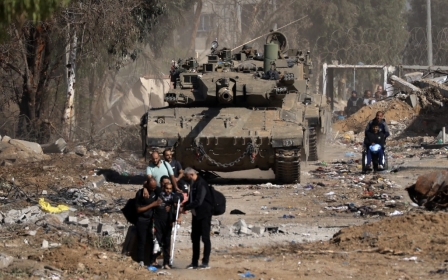Israel-Palestine: Repeatedly displaced, Gaza's terrified population have nowhere 'safe' to go

Tying mattresses to the roof of their car, Aya Fehmi and her family said they would be returning to what remained of their home in the central Gaza Strip.
They had evacuated Gaza City's Tal al-Hawa neighbourhood during the fourth week of Israel's ferocious assault on the besieged Palestinian enclave, when air strikes were raining down on the city.
But, following the end of the pause in fighting on Friday, the Israeli military began dropping leaflets were she was currently staying, telling Palestinians in Khan Younis that it was also now declared a "fighting zone" and they would have to flee once again.
Speaking to Middle East Eye, Fehmi, a 34-year-old mother of three boys, said that she had already been displaced three times and didn't know where to seek safety.
"We left our home [in Gaza City] after we received messages [from the Israeli military] saying that our neighbourhoods would be targeted. We moved to a relative's home in Deir al-Balah and stayed there for three weeks," Fehmi said.
New MEE newsletter: Jerusalem Dispatch
Sign up to get the latest insights and analysis on Israel-Palestine, alongside Turkey Unpacked and other MEE newsletters
"Then we decided to move again, to another relative's home in Khan Younis as we thought the area was safer, and there was also more food [available] in the markets in there than in Deir al-Balah.
"We were staying with around 30 other people in the garage of the building, but we did not have any other choice. This is the only family we know in the south."
Fehmi said she also learned during last week's pause that her home in Gaza City's Tal al-Hawa neighbourhood had been completely destroyed.
"For a month-and-a-half we didn't know anything about our home. We only knew that our neighbourhood was threatened and that hundreds of homes had been bombed," she told MEE.
"When the truce started [on 24 October], we were sent a photo of our building. It had been completely turned into rubble. I cried for two days non-stop.
"We had bought this apartment when we got married, and I chose every single object in it. My husband and I both work, and over the past eight years we saved money to buy a new piece of furniture every couple of months."
Order to evacuate
On Thursday night, Fehmi went to sleep with the hope of waking up to news that the truce had been extended and it would eventually lead to a comprehensive ceasefire.
However, when she awoke, she was told by her husband that they needed to pack up their belongings and move yet again.
Follow Middle East Eye's live coverage for the latest on the Israel-Palestine war
"I was half asleep, hearing bombs, thinking I was dreaming. My husband told me the Israelis had dropped leaflets on Khan Younis asking its residents to go to Rafah. We don't know anyone there, so we decided to return to Deir al-Balah," she said.
"We packed our bags again for the third time and rushed to Deir al-Balah. A few hours later, we heard news that we might be displaced again from this area."
On Friday, the Israeli military published a map of the Gaza Strip where it was divided into 2,300 numbered blocks
According to the army, it intends to order the residents of certain blocks to move to others as part of a new plan of displacement.
Intense bombardment
The map was published on the Israeli army's website and its social media channels. However, the vast majority of the Gaza Strips's residents lack access to the internet, due to a Israel cutting electricity supplies and and telecommunication and internet being targeted by Israeli forces.
"My husband managed to connect to the internet using an eSIM, and a relative abroad had sent him a screenshot of the map," Fehmi told MEE.
'World leaders said that they would not allow a second Nakba... but what we see on the ground are new phases of this eviction plan'
- Aya Fehmi, Gaza resident
"However, we cannot identify our block number because the map is scattered with numbers and the blocks are very small. We do not know if we are currently staying within a safe or threatened area."
A few hours after they evacuated Khan Younis, Israeli forces began an intense bombardment campaign of its neighbourhoods, flattening residential buildings and killing dozens of people who had taken refuge there based on previous instructions by the Israeli military.
"The occupation does not seem to have a stable plan. Every couple of days, they come up with a new decision," Fehmi told MEE.
"Who would guarantee us that if we were displaced for the fourth time and moved to another area we would not be displaced for a fifth and sixth time?
"Who would guarantee that we would not be expelled to Sinai?
"World leaders said that they would not allow a second Nakba, and that the people of Gaza would not be evacuated to Sinai, but what we see on the ground are new phases of this eviction plan.
"I cannot imagine that this is happening in the 21st century and that the world is allowing it to continue."
This article is available in French on Middle East Eye French edition.
Middle East Eye delivers independent and unrivalled coverage and analysis of the Middle East, North Africa and beyond. To learn more about republishing this content and the associated fees, please fill out this form. More about MEE can be found here.




